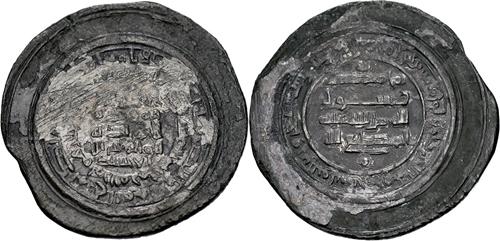
|
Ikhshidids. Abu'l-Qasim Unujur. AH 334-349 / AD 946-960. AR Double Dirham (25mm, 4.93 g, 2h). Medallic type with broad margins on both sides. Madinat Ramla (or Madinat Ramallah?) mint. Dated AH 336 (AD 948). Good Fine, dark surfaces, cleaning scratches in
Islamic Auction 7 - Session One
Lot: 129. Estimated: $ 7 500
Egypt and Syria, Silver
Sold For $ 14 000. This amount does not include the buyer’s fee.
Go to Live
|
|
Ikhshidids. Abu'l-Qasim Unujur. AH 334-349 / AD 946-960. AR Double Dirham (25mm, 4.93 g, 2h). Medallic type with broad margins on both sides. Madinat Ramla (or Madinat Ramallah?) mint. Dated AH 336 (AD 948). Obverse: Abu’l-Qasim ibn / al-Ikhshid in fourth and fifth lines / Reverse: letter ra in field, below the name of the caliph al-Muti‘ lillah. Bacharach –. Good Fine, dark surfaces, cleaning scratches in obverse field. Of the highest rarity, apparently unpublished and believed unique.
The mint-name on this remarkable donative coin looks closer to ‘Madinat Ramallah,’ with three vertical letters before the final ta marbuta. But Ramallah was barely a village in the Ikhshidid period, and it seems more likely that the more important city of Ramla was intended here.
Standard Ikhshidid dirhams struck at Tabariya in this year feature the initial letter teh in the reverse field, placed below the name of the caliph. This can be plausibly interpreted as the initial letter of the mint-name Tabariya; if so, it would then be paralleled by the letter ra similarly positioned on the present coin.
It has not been possible to identify a precise historical event which might explain the striking of this coin, but the historical background is certainly suggestive. Unujur and his army had been in Damascus in AH 334, but returned to Egypt after the death of Muhammad al-Ikhshid at the end of the year. This allowed the Hamdanid ruler, Sayf al-Dawla, to occupy Damascus in AH 335. Unujur therefore marched eastwards to confront Sayf al-Dawla, who himself advanced westwards to engage the Ikhshidids in Palestine. A battle took place between the two armies in the following year during which the Unujur was victorious, although fighting between the Ikhshidids and the Hamdanids continued well into the following year. While the eventual outcome was a treaty between the two sides rather than outright victory for either, the terms were certainly better for the Ikhshidids than under previous settlements, whereby they had been previously obliged to pay annual tribute to the Hamdanids in order to keep the peace.
For another Ikhshidid donative dirham, without mint and date and with different legends, which Bacharach also suggests was likely struck to mark Ikhshidid successes during this campaign, see Bacharach (op. cit.) p. 77 and note 17.
Closing Date and Time: at 14:42:40 ET.
|
